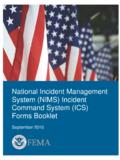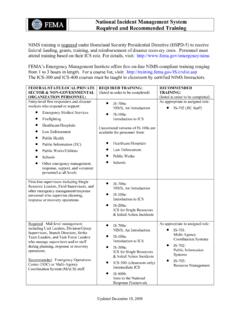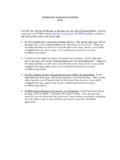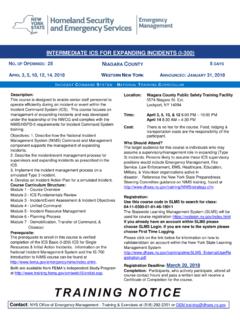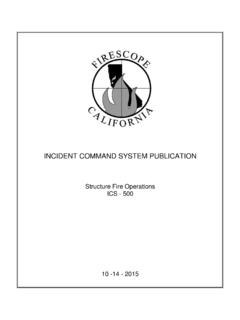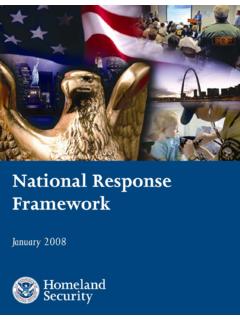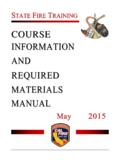Transcription of BY ORDER OF THE AIR FORCE MANUAL 10-2502 …
1 BY ORDER OF THE SECRETARY OF THE AIR FORCE AIR FORCE MANUAL 10-2502 25 SEPTEMBER 2009 Operations AIR FORCE incident management system (AFIMS) STANDARDS AND PROCEDURES COMPLIANCE WITH THIS PUBLICATION IS MANDATORY ACCESSIBILITY: Publications and forms are available for downloading or ordering on the e-Publishing website at RELEASABILITY: There are no releasability restrictions on this publication. OPR: HQ AFCESA/CEXR Certified by: HQ USAF/A7C (Brig Gen Timothy A. Byers) Pages: 82 This MANUAL implements Air FORCE Policy Directive (AFPD) 10-2, Readiness; AFPD 10-25, Emergency management ; and Air FORCE Instruction (AFI) 10-2501, Air FORCE Emergency management (EM) Program Planning and Operations. It also aligns the Air FORCE Emergency management Program with Homeland Security Presidential Directive 5 (HSPD-5), the National incident management system (NIMS), and the National Response Framework (NRF).
2 This MANUAL supplements the Air FORCE incident management system (AFIMS) based on the NIMS methodology and aligns Air FORCE EM planning and response with the NRF as directed by HSPD-5. I t also establishes responsibilities, procedures and standards for prevention, preparedness, response, recovery, and mitigation resulting from major accidents, natural disasters, contingency/wartime and irregular enemy attacks with Chemical, Biological, Radiological, Nuclear, and High-Yield Explosive (CBRNE) weapons within the Continental United States (CONUS) and Outside the Continental United States (OCONUS). This publication applies to Active Duty, Air FORCE Reserve Command, and Air National Guard units. Consult cited policy directives, instructions, manuals, and their supplements for specific policies, procedures, and requirements.
3 Send recommended changes and major command (MAJCOM) supplements to this publication to Headquarters (HQ) AFCESA/CEXR, 139 Barnes Drive, Tyndall AFB, FL 32403-5319. Use Air FORCE (AF) Information management Tool (IMT) 847, Recommendation for Change of Publication for recommended changes. Ensure all records created because of processes prescribed in this publication are maintained in accordance with (IAW) Air FORCE MANUAL (AFMAN) 33-363 , management of Records and disposed of IAW the Air FORCE Records Disposition Schedule (RDS) located at Certified Current, 26 September 20112 AFMAN10-2502 25 SEPTEMBER 2009 Chapter 1 OVERVIEW AND POLICY 4 Overview.. 4 Purpose.. 4 National Policies.. 4 Chapter 2 AIR FORCE incident management system (AFIMS) 9 Air FORCE incident management system (AFIMS).
4 9 incident Command system (ICS).. 10 The Disaster Response FORCE (DRF) Structure, Installation Level.. 10 Table DRF Elements.. 10 Table ECC Capabilities.. 12 Interoperability.. 14 Table Samples of NIMS Terminology.. 15 Integrated Operations.. 16 Chapter 3 PREVENTION AND PREPAREDNESS 18 Analysis and Vulnerability Assessment Process.. 18 AFIMS Planning.. 18 Capabilities-Based Planning.. 18 Crisis Action Planning.. 19 Interaction and Integration of Installation Plans.. 19 Table Plans Related to CEMP 10-2.. 19 Interaction and Integration of Other Plans.. 20 Training and Exercises.. 21 Chapter 4 RESPONSE AND RECOVERY 22 Overarching Response and Recovery Principles.
5 22 Table Examples of Response Actions.. 23 Use of IAP.. 24 Table Recommended ICS Forms .. 24 Figure Primary Phases of IAP Development.. 24 Table Sample IAP Outline.. 25 Figure Use of Installation Planning Documents to Form IAP.. 26 Support.. 26 AFMAN10-2502 25 SEPTEMBER 2009 3 Figure Request for Forces Process.. 27 AFIMS Response and Recovery Challenges.. 28 Lessons Learned and After-Action Reporting.. 28 Figure Air FORCE Lessons Learned Process.. 30 Chapter 5 INFORMATION COLLECTION, RECORDS, AND FORMS 31 Information Collections.. 31 Records.. 31 Prescribed and Adopted Forms.. 31 Attachment 1 GLOSSARY OF REFERENCES AND SUPPORTING INFORMATION 32 Attachment 2 incident COMMAND system (ICS) 48 Attachment 3 AIR FORCE EMERGENCY SUPPORT FUNCTIONS (ESF) 70 Attachment 4 COMMAND AND CONTROL ELEMENTS FOR incident management 78 Attachment 5 incident TYPES 80 4 AFMAN10-2502 25 SEPTEMBER 2009 Chapter 1 OVERVIEW AND POLICY Overview.
6 Since September 11, 2001, there have been sweeping changes to emergency response procedures and operations. The impetus for this MANUAL comes from the following new guidance HSPD 5, management of Domestic Incidents, the National Response Framework (NRF), and the Assistant Secretary of Defense (SecDef), Homeland Defense (26 January 2004) memorandum, which mandates that both of the aforementioned publications be integrated into Department of Defense (DOD) existing incident management and emergency response plans. Procedures for detailed planning, organization, training, and response and recovery information are in AFMAN 10-2503, Chemical, Biological, Radiological, Nuclear, and High-Yield Explosive Operations and AFMAN 10-2504, Air FORCE incident management Guidance for Major Accidents and Natural Disasters.
7 Purpose. This MANUAL implements AFPD 10-2, Readiness; AFPD 10-25, Emergency management , and AFI 10-2501, Air FORCE Emergency management (EM) Program Planning and Operations. This MANUAL provides higher headquarters (HHQs), installations, and unit commanders with EM program guidance, including the structure and responsibilities of the AFIMS. National Policies. The following are national policies related to disaster and contingency situations in which the AFIMS will be used. Robert T. Stafford Disaster Relief and Emergency Assistance Act, Title 42 United States Code, Section 5121 (hereafter referred to as the Stafford Act). The Stafford Act is a 1988 amended version of the Disaster Relief Act of 1974. The Stafford Act provides an orderly and continuing means for supplemental assistance to state and local governments in their responsibilities to alleviate the suffering and damage that result from major disasters and emergencies.
8 Upon declaring a major disaster or emergency, the President may direct any agency of the Federal government, including DOD, to undertake missions and tasks to support State and local agencies. Homeland Security Act of 2002. The Homeland Security Act of 2002 established the Department of Homeland Security (DHS). The act also cited the Stafford Act and stated that the President has broad powers that may be invoked in the event of domestic emergencies, including an attack against the nation using weapons of mass destruction (WMD). The President is specifically authorized to use the Armed Forces to help restore public ORDER , but stated that the Office of Homeland Security cannot engage in warfighting, the military defense of the United States, or other military activities. The Homeland Security Act does not limit the existing authority of the DOD.
9 HSPD-5 Policies, management of Domestic Incidents. HSPD-5 requires the Federal government to establish a single, comprehensive approach to domestic incident management . It also requires the DHS to coordinate with other Federal departments and agencies and State, local, and tribal governments to establish a NRF and a NIMS. HSPD-8 Policy, National Preparedness. HSPD-8, which is a companion to HSPD-5, established policies to strengthen the preparedness of the United States to prevent and AFMAN10-2502 25 SEPTEMBER 2009 5 respond to threats and actual domestic terrorist attacks, major disasters, and other emergencies. NRF Policy. HSPD-5 directs the Secretary of Homeland Security to develop and administer a NRF to integrate Federal domestic prevention, preparedness, response and recovery plans into a single, all-discipline, all-hazards plan.
10 The NRF attempts to prevent terrorist attacks within the United States; reduce America's vulnerability to terrorism, major disasters, and other emergencies; and minimize the damage and recovery from attacks, major disasters, and other emergencies. The NRF describes the policies, planning assumptions and operational concepts that guide Federal operations following a presidential declaration of a major disaster or emergency. Like the NIMS, the NRF incorporates best practices and procedures from various disciplines and integrates them into a unified coordinating structure. The NRF distinguishes between large-scale events that require DHS coordination and the majority of incidents occurring each year that are handled by responsible jurisdictions or agencies through other established authorities or existing plans.










